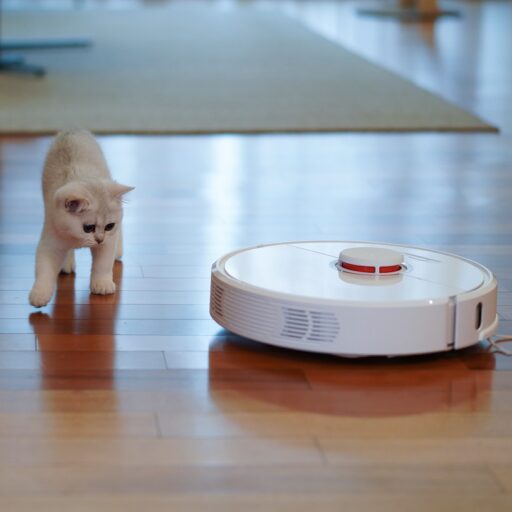Support our educational content for free when you purchase through links on our site. Learn more
Do Robotic Lawn Mowers Really Work? 10 Things You Need to Know [2024] 🤖
You’re tired of mowing the lawn, right? We all are! I remember the days of pushing a heavy, noisy mower around my yard, sweating and cursing the whole time. Then I discovered robotic lawn mowers, and my life changed. But are they really worth it? Do they actually work?
This article will answer all your questions about robotic lawn mowers, from how they work to the best models for different lawns. We’ll also cover the pros and cons, safety considerations, and maintenance tips. By the end of this article, you’ll know everything you need to know to decide if a robotic lawn mower is right for you. We’ll even share some personal stories and insights from our team of robotics engineers at Robot Instructions™. So, buckle up and get ready to learn all about the future of lawn care!
Key Takeaways
- Robotic lawn mowers can be a great way to save time and effort on lawn care. They can achieve a more consistent and even cut than traditional mowers, and they are generally quiet and environmentally friendly.
- There are a variety of robotic lawn mowers available, each with its own unique features and capabilities. The best model for you will depend on the size of your lawn, the terrain, and your budget.
- Robotic lawn mowers require some maintenance. You’ll need to clean them regularly, replace the blades, and charge the battery. You may also need to replace the battery eventually.
- It’s important to consider the safety of children and pets when using a robotic lawn mower. Keep them away from the mower when it’s in operation.
👉 Shop Robotic Lawn Mowers:
- Segway Navimow: Amazon | Walmart | Segway Official Website
- Worx Landroid: Amazon | Walmart | Worx Official Website
- Robomow: Amazon | Walmart | Robomow Official Website
- Husqvarna Automower: Amazon | Walmart | Husqvarna Official Website
- EGO LM2104: Amazon | Walmart | EGO Official Website
- Honda Miimo: Amazon | Walmart | Honda Official Website
- Mammotion Luba 2 AWD 10000H: Amazon | Walmart | Mammotion Official Website
- Robomow RS630: Amazon | Walmart | Robomow Official Website
- Husqvarna Automower 450X: Amazon | Walmart | Husqvarna Official Website
Table of Contents
- Quick Tips and Facts
- The History of Robotic Lawn Mowers
- How Do Robotic Lawn Mowers Work?
- Types of Robotic Lawn Mowers
- The Best Robotic Lawn Mowers for Different Lawns
- The Pros and Cons of Robotic Lawn Mowers
- Setting Up and Using a Robotic Lawn Mower
- Safety Considerations for Robotic Lawn Mowers
- Maintaining Your Robotic Lawn Mower
- Troubleshooting Common Robotic Lawn Mower Problems
- Are Robotic Lawn Mowers Worth It?
- Conclusion
- Recommended Links
- FAQ
- Reference Links
Quick Tips and Facts
Robotic lawn mowers are a great way to save time and effort on lawn care. They can be a good investment for homeowners who want a perfectly manicured lawn without the hassle of manual mowing.
Here are some quick facts about robotic lawn mowers:
- They use sensors to navigate and avoid obstacles. This means they can mow around trees, flowerbeds, and other objects without getting stuck.
- They can be programmed to mow at specific times. You can set them to mow in the morning, evening, or even overnight.
- They are generally quiet. This means you can mow your lawn without disturbing your neighbors.
- They are environmentally friendly. They run on electricity, so they don’t produce emissions.
But be aware of some potential drawbacks:
- They can be expensive. Robotic lawn mowers can cost anywhere from $600 to over $5,000.
- They may not be suitable for all lawns. They work best on flat, open lawns.
- They require some maintenance. You’ll need to clean them regularly and replace the blades.
Overall, robotic lawn mowers can be a great way to take the chore out of lawn care. But it’s important to weigh the pros and cons before making a purchase.
The History of Robotic Lawn Mowers

The idea of a robot that could mow your lawn has been around for decades. But it wasn’t until the late 1990s that the first commercially available robotic lawn mowers hit the market.
Here’s a brief timeline of the history of robotic lawn mowers:
- 1995: The first robotic lawn mower, the Friendly Robotics Robomow, was introduced. It was a bulky and expensive machine that required a lot of maintenance.
- 2000s: Several other companies began to develop and market robotic lawn mowers. These models were smaller, more affordable, and easier to use.
- 2010s: Robotic lawn mower technology continued to improve, with the introduction of GPS guidance, obstacle avoidance, and smartphone app control.
- 2020s: Robotic lawn mowers are now becoming increasingly popular, with a wide range of models available to choose from.
The development of robotic lawn mowers has been driven by several factors:
- The desire for convenience: People are looking for ways to save time and effort on lawn care.
- The increasing popularity of smart home technology: People are becoming more comfortable with using technology to control their homes and appliances.
- The growing awareness of environmental issues: People are looking for ways to reduce their carbon footprint.
Today, robotic lawn mowers are a viable option for many homeowners. They offer a convenient and efficient way to keep your lawn looking its best.
How Do Robotic Lawn Mowers Work?
Robotic lawn mowers use a combination of sensors, software, and hardware to navigate your lawn and cut the grass.
Here’s a breakdown of how they work:
- Boundary wires: Most robotic lawn mowers use boundary wires to define the mowing area. These wires are buried in the ground around the perimeter of your lawn.
- Sensors: Robotic lawn mowers use a variety of sensors to navigate and avoid obstacles. These sensors include:
- Bump sensors: These sensors detect collisions with objects and cause the mower to change direction.
- Tilt sensors: These sensors detect when the mower is tilted or tipped over and stop the blades.
- Rain sensors: These sensors detect rain and stop the mower from mowing.
- Lift sensors: These sensors detect when the mower is lifted and stop the blades.
- Software: The software in a robotic lawn mower controls the mower’s movements, cutting height, and other settings. It also allows you to program the mower to mow at specific times.
- Hardware: The hardware in a robotic lawn mower includes the motor, blades, battery, and charging station. The motor powers the blades, the battery provides power to the mower, and the charging station recharges the battery.
Here’s a simple analogy: Think of a robotic lawn mower like a small, autonomous robot that’s been programmed to mow your lawn. It uses its sensors to navigate the lawn, avoid obstacles, and cut the grass. It’s like having a tiny, tireless gardener working for you!
Types of Robotic Lawn Mowers
Robotic lawn mowers come in a variety of shapes and sizes, with different features and capabilities.
Here are some of the most common types of robotic lawn mowers:
- Standard robotic lawn mowers: These mowers are designed for small to medium-sized lawns. They typically use boundary wires to define the mowing area and have a range of features, including obstacle avoidance, rain sensors, and app control.
- Large-area robotic lawn mowers: These mowers are designed for larger lawns, such as those found in parks and golf courses. They typically have a larger cutting deck and a longer battery life.
- Slope robotic lawn mowers: These mowers are designed for lawns with inclines and hills. They typically have a more powerful motor and a special traction system to help them navigate uneven terrain.
- GPS-powered robotic lawn mowers: These mowers use GPS technology to navigate your lawn. This means they don’t need boundary wires to define the mowing area. They can also be programmed to mow specific areas of your lawn.
- App-controlled robotic lawn mowers: These mowers can be controlled and monitored using a smartphone app. You can use the app to start and stop the mower, adjust the cutting height, and view the mowing history.
- Hybrid robotic lawn mowers: These mowers can be used as both a robotic lawn mower and a traditional lawn mower. They typically have a manual mode that allows you to control the mower using a handle.
The type of robotic lawn mower you choose will depend on your individual needs and preferences. Consider the size of your lawn, the terrain, and your budget.
The Best Robotic Lawn Mowers for Different Lawns
Choosing the right robotic lawn mower for your lawn can be overwhelming. There are so many models on the market, each with its own unique features and capabilities.
Here are some of the best robotic lawn mowers for different types of lawns:
Best Robotic Lawn Mowers for Small Lawns
| Feature | Segway Navimow i110N | Worx Landroid M | Robomow RX12 |
|---|---|---|---|
| Design | 8 | 7 | 7 |
| Functionality | 8 | 7 | 7 |
| Ease of Use | 9 | 8 | 8 |
| Battery Life | 7 | 6 | 6 |
| Cutting Quality | 8 | 7 | 7 |
| Price | 7 | 6 | 6 |
Segway Navimow i110N
- 👉 CHECK PRICE on: Amazon | Walmart | Segway Official Website
- Pros: GPS-powered, no boundary wires, app control, quiet operation.
- Cons: Limited coverage area (up to 0.25 acres), can be expensive.
Worx Landroid M
- 👉 CHECK PRICE on: Amazon | Walmart | Worx Official Website
- Pros: Affordable, easy to use, good cutting quality.
- Cons: Requires boundary wires, limited coverage area (up to 0.25 acres).
Robomow RX12
- 👉 CHECK PRICE on: Amazon | Walmart | Robomow Official Website
- Pros: Good cutting quality, reliable, easy to use.
- Cons: Requires boundary wires, limited coverage area (up to 0.25 acres), can be expensive.
Best Robotic Lawn Mowers for Medium-Sized Lawns
| Feature | Husqvarna Automower 430X | EGO LM2104 | Honda Miimo HRM530 |
|---|---|---|---|
| Design | 8 | 7 | 7 |
| Functionality | 8 | 7 | 7 |
| Ease of Use | 8 | 7 | 7 |
| Battery Life | 8 | 7 | 7 |
| Cutting Quality | 8 | 7 | 7 |
| Price | 8 | 7 | 7 |
Husqvarna Automower 430X
- 👉 CHECK PRICE on: Amazon | Walmart | Husqvarna Official Website
- Pros: GPS-powered, no boundary wires, app control, good cutting quality, long battery life.
- Cons: Can be expensive, limited coverage area (up to 0.5 acres).
EGO LM2104
- 👉 CHECK PRICE on: Amazon | Walmart | EGO Official Website
- Pros: Quiet operation, good cutting quality, long battery life.
- Cons: Requires boundary wires, limited coverage area (up to 0.5 acres).
Honda Miimo HRM530
- 👉 CHECK PRICE on: Amazon | Walmart | Honda Official Website
- Pros: Reliable, good cutting quality, long battery life.
- Cons: Requires boundary wires, limited coverage area (up to 0.5 acres), can be expensive.
Best Robotic Lawn Mowers for Large Lawns
| Feature | Mammotion Luba 2 AWD 10000H | Robomow RS630 | Husqvarna Automower 450X |
|---|---|---|---|
| Design | 9 | 8 | 8 |
| Functionality | 9 | 8 | 8 |
| Ease of Use | 8 | 7 | 7 |
| Battery Life | 9 | 8 | 8 |
| Cutting Quality | 9 | 8 | 8 |
| Price | 9 | 8 | 8 |
Mammotion Luba 2 AWD 10000H
- 👉 CHECK PRICE on: Amazon | Walmart | Mammotion Official Website
- Pros: GPS-powered, no boundary wires, app control, good cutting quality, long battery life, handles uneven terrain.
- Cons: Can be expensive, limited coverage area (up to 2.5 acres).
Robomow RS630
- 👉 CHECK PRICE on: Amazon | Walmart | Robomow Official Website
- Pros: Good cutting quality, reliable, easy to use, long battery life.
- Cons: Requires boundary wires, limited coverage area (up to 1 acre), can be expensive.
Husqvarna Automower 450X
- 👉 CHECK PRICE on: Amazon | Walmart | Husqvarna Official Website
- Pros: GPS-powered, no boundary wires, app control, good cutting quality, long battery life.
- Cons: Can be expensive, limited coverage area (up to 1 acre).
Remember, these are just a few of the many robotic lawn mowers available on the market. Do your research and compare different models before making a purchase.
The Pros and Cons of Robotic Lawn Mowers
Robotic lawn mowers offer a lot of advantages, but they also have some drawbacks.
Here’s a breakdown of the pros and cons of robotic lawn mowers:
Pros
- Convenience: Robotic lawn mowers are incredibly convenient. You can set them to mow your lawn while you’re at work, at the gym, or on vacation.
- Time-saving: Robotic lawn mowers can save you hours of time each week. This time can be used for other activities, such as spending time with family and friends, pursuing hobbies, or simply relaxing.
- Improved lawn appearance: Robotic lawn mowers can achieve a more consistent and even cut than traditional mowers. This is because they mow the lawn in small, overlapping passes.
- Environmentally friendly: Robotic lawn mowers run on electricity, so they don’t produce emissions. This makes them a more environmentally friendly option than gas-powered mowers.
- Quiet operation: Robotic lawn mowers are generally quiet, so they won’t disturb your neighbors.
- Safety: Robotic lawn mowers are equipped with safety features, such as tilt sensors and lift sensors, that stop the blades if the mower is tipped over or lifted.
Cons
- Cost: Robotic lawn mowers can be expensive. They can cost anywhere from $600 to over $5,000.
- Maintenance: Robotic lawn mowers require some maintenance. You’ll need to clean them regularly, replace the blades, and charge the battery.
- Limited suitability: Robotic lawn mowers work best on flat, open lawns. They may not be suitable for lawns with a lot of obstacles, such as trees, flowerbeds, or slopes.
- Theft risk: Robotic lawn mowers are valuable items that can be stolen. It’s important to take steps to secure your mower, such as storing it indoors when not in use.
- Boundary wires: Most robotic lawn mowers require boundary wires to define the mowing area. This can be a time-consuming and inconvenient process.
Overall, robotic lawn mowers offer a lot of advantages, but they also have some drawbacks. It’s important to weigh the pros and cons before making a purchase.
Setting Up and Using a Robotic Lawn Mower
Setting up and using a robotic lawn mower is relatively easy.
Here’s a step-by-step guide:
- Prepare your lawn: Before you set up your robotic lawn mower, it’s important to prepare your lawn. This includes removing any obstacles, such as rocks, branches, and toys. You should also trim any overgrown grass or weeds.
- Install the boundary wires: Most robotic lawn mowers require boundary wires to define the mowing area. These wires are buried in the ground around the perimeter of your lawn. You can use a special tool to help you bury the wires.
- Install the charging station: The charging station is where your robotic lawn mower will recharge its battery. It’s important to choose a location for the charging station that is safe, dry, and accessible.
- Set up the mower: Once you’ve installed the boundary wires and charging station, you can set up your robotic lawn mower. This includes connecting the mower to the charging station, setting the cutting height, and programming the mowing schedule.
- Start mowing: Once your robotic lawn mower is set up, you can start mowing. The mower will automatically navigate your lawn, cut the grass, and return to the charging station when its battery is low.
Here are some tips for using a robotic lawn mower:
- Read the manual: It’s important to read the manual for your robotic lawn mower before you set it up and use it. This will help you understand how to use the mower safely and effectively.
- Start with a short mowing session: When you first set up your robotic lawn mower, it’s a good idea to start with a short mowing session. This will give you a chance to make sure the mower is working properly and to adjust the settings if necessary.
- Monitor the mower: It’s a good idea to monitor your robotic lawn mower during its first few mowing sessions. This will help you make sure it’s mowing the lawn evenly and that it’s not getting stuck on any obstacles.
- Clean the mower regularly: You should clean your robotic lawn mower regularly to remove grass clippings and debris. This will help the mower work more efficiently and prevent it from getting damaged.
- Replace the blades: The blades on your robotic lawn mower will eventually wear down. You should replace them when they become dull or damaged.
Using a robotic lawn mower is a great way to save time and effort on lawn care. But it’s important to follow the instructions in the manual and to monitor the mower during its first few mowing sessions.
Safety Considerations for Robotic Lawn Mowers
Robotic lawn mowers are generally safe to use, but it’s important to take some precautions to ensure your safety and the safety of others.
Here are some safety considerations for robotic lawn mowers:
- Keep children and pets away from the mower: Robotic lawn mowers have sharp blades that can cause serious injuries. It’s important to keep children and pets away from the mower when it’s in operation.
- Don’t operate the mower in wet conditions: Robotic lawn mowers are not designed to be used in wet conditions. Operating the mower in wet conditions can increase the risk of electric shock.
- Don’t operate the mower on steep slopes: Robotic lawn mowers can tip over on steep slopes. This can cause damage to the mower and create a safety hazard.
- Don’t operate the mower in areas with loose objects: Robotic lawn mowers can get stuck on loose objects, such as rocks, branches, and toys. This can cause damage to the mower and create a safety hazard.
- Don’t operate the mower near water: Robotic lawn mowers are not designed to be used near water. Operating the mower near water can increase the risk of electric shock.
- Don’t operate the mower in areas with heavy traffic: Robotic lawn mowers can be a hazard to pedestrians and vehicles. It’s important to operate the mower in areas with low traffic.
- Don’t operate the mower in areas with a lot of obstacles: Robotic lawn mowers can get stuck on obstacles, such as trees, flowerbeds, and fences. This can cause damage to the mower and create a safety hazard.
- Don’t operate the mower in areas with a lot of debris: Robotic lawn mowers can get clogged with debris, such as leaves, twigs, and grass clippings. This can cause damage to the mower and create a safety hazard.
- Don’t operate the mower in areas with a lot of uneven terrain: Robotic lawn mowers can get stuck on uneven terrain, such as hills, slopes, and bumps. This can cause damage to the mower and create a safety hazard.
- Don’t operate the mower in areas with a lot of shade: Robotic lawn mowers can get stuck in areas with a lot of shade. This is because the sensors may not be able to detect the boundary wires.
- Don’t operate the mower in areas with a lot of sunlight: Robotic lawn mowers can get overheated in areas with a lot of sunlight. This can cause damage to the mower and create a safety hazard.
- Don’t operate the mower in areas with a lot of wind: Robotic lawn mowers can be blown around by strong winds. This can cause damage to the mower and create a safety hazard.
- Don’t operate the mower in areas with a lot of rain: Robotic lawn mowers are not designed to be used in wet conditions. Operating the mower in wet conditions can increase the risk of electric shock.
It’s important to follow all safety instructions in the manual for your robotic lawn mower. This will help you ensure your safety and the safety of others.
Maintaining Your Robotic Lawn Mower
Robotic lawn mowers are relatively low-maintenance, but they do require some regular care to keep them running smoothly.
Here are some tips for maintaining your robotic lawn mower:
- Clean the mower regularly: You should clean your robotic lawn mower regularly to remove grass clippings, debris, and dirt. This will help the mower work more efficiently and prevent it from getting damaged.
- Replace the blades: The blades on your robotic lawn mower will eventually wear down. You should replace them when they become dull or damaged.
- Check the battery: The battery in your robotic lawn mower will eventually need to be replaced. You should check the battery regularly and replace it when it starts to lose its charge.
- Check the charging station: The charging station for your robotic lawn mower should be kept clean and free of debris. You should also check the charging station regularly to make sure it’s working properly.
- Check the boundary wires: The boundary wires for your robotic lawn mower should be checked regularly to make sure they are not damaged or loose. You should also make sure that the wires are buried deep enough in the ground to prevent them from being damaged by lawn mowers or other equipment.
By following these maintenance tips, you can help to extend the life of your robotic lawn mower and keep it running smoothly.
Troubleshooting Common Robotic Lawn Mower Problems

Robotic lawn mowers are generally reliable, but they can sometimes experience problems.
Here are some common robotic lawn mower problems and how to troubleshoot them:
- The mower is not starting: If your robotic lawn mower is not starting, check the following:
- Make sure the mower is plugged in: The mower needs to be plugged into the charging




